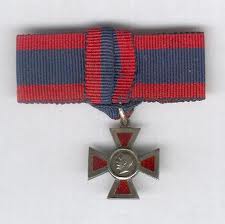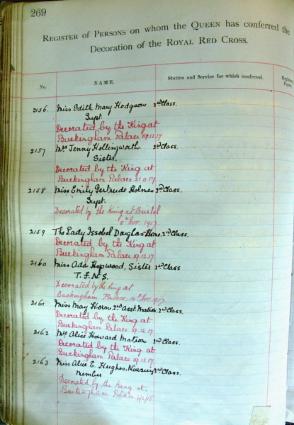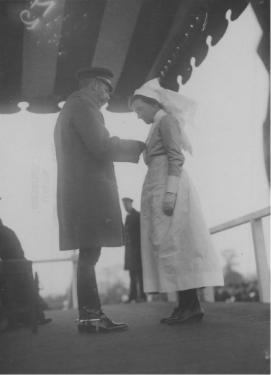THE ROYAL RED CROSS AND THE GREAT WAR
*****

*****
The Royal Red Cross (RRC) was first instituted in April 1883:
To confer the decoration upon any ladies, whether subjects or foreign persons who may be recommended to Our notice by Our Secretary of State for War for special exertions in providing for the nursing, or for attending to, sick and wounded soldiers and sailors ... (and) for special competency which they may have displayed in their nursing duties with Our Army in the Field, or in Our Naval and Military Hospitals.
By the outbreak of the Great War in August 1914, so special was this award that only 246 women had been considered worthy of the honour during the preceding thirty-one years. They had been decorated for their services during the Zulu War, the 1st Anglo-Boer War, the Sudan and Nile Campaigns, the 2nd Anglo-Boer War; for their work with the West African Frontier Force in 1899, and for duties in India over many years. The number also included several awards to members of both the British and European Royal families for their organisational and administrative connection with nursing rather than their direct involvement in practical care. However, things were set to change during the Great War. At first, the number of awards continued at its previous slow pace. The first wartime RRC was in October 1914 to a French civilian, Eugènie Antoine:
In recognition of her courageous and devoted services to the British wounded in hospital at Vailly-sur-Aisne whilst the village was under shell fire
and there was then not another until the end of February 1915 – a single RRC to a member of Queen Alexandra’s Royal Naval Nursing Service.
As the war progressed the number of hospitals and staff increased dramatically, and in November 1915 a second class of the Royal Red Cross was instituted by amendment to the Royal Warrant. This new class, the Associate Royal Red Cross (ARRC) could be conferred on a greater proportion of women than previously – up to 5% of the total nursing establishment – and also allowed for honorary awards to those involved in voluntarily establishing and running hospitals, even if not directly carrying out nursing duties. The floodgates were opened.
By the last day of 1915 the total number of awards of the Royal Red Cross since its inception in 1883 stood at 288. Twelve months later, another 644 awards had been added – more than twice as many in twelve months than in the whole of the first thirty-two years. Numbers continued to rise and the decoration was becoming something rather different from the great honour originally intended. It was now expected by many wealthy, philanthropic women as an accolade for services rendered in spending their own money and opening their own homes to care for the sick and wounded of war. The names in the Royal Red Cross Registers held at The National Archives show that the Commandants of many voluntary hospitals, with little or no nursing training or experience, received recognition, while their staff went empty-handed. They were the figureheads and as such accepted the bouquets.

A page from the RRC Register (The National Archives WO145/1)
Members of the military nursing services of the Dominions received a far higher number of RRCs and ARRCs as a percentage of their nursing establishments compared to the British, with Canada and Australia faring particularly well. Maybe this could be seen as a reward to those countries for baling out Great Britain when the shortage of trained nurses started to bite. Alongside that, the VADs – members of Voluntary Aid Detachments – were poorly represented, with very few awards relative to their number. More than 70,000 nursing VADs served at some time during the Great War, many serving with distinction abroad under the same demanding and harrowing conditions as their trained colleagues, but it seems they were far easier to pass over in honours lists than their eminent Matrons and Commandants. From December 1917 a nurse could be awarded a Bar to her Royal Red Cross, and during the Great War eighty-two women received this ultimate honour, all senior members of the military nursing services.
The last, rather belated Great War ARRC, was announced in the London Gazette in September 1922. In total, 6419 individual women received 6741 RRCs, Bars, and ARRCs between them, the discrepancy in numbers being accounted for by those who had their original award upgraded at sometime between 1915 and 1921. In addition, twenty-six nurses who received the RRC or ARRC during the Great War had it upgraded during the period 1922-1946.
The RRC Registers tell a story of a desperate need to reward women for their work during the Great War, seemingly often based on perceived social status or nursing seniority rather than the actual performance of duties. This situation was never allowed to happen again. During the Second World War, over a far longer period, there were just over 1300 awards of the Royal Red Cross in both classes, and that decline continued and gathered pace. During the ten years from 1996 to 2006 it was conferred on just forty occasions. The Royal Red Cross had returned to its prestigious beginnings, as a worthy honour for the finest military nurses.

Emily Holmes receives her decoration from the King at Bristol, November 1917
*****
A transcription of all entries in the Royal Red Cross Register between 1883 and 1994 is now included on FindMyPast, and can be searched by name. The only details that are not reproduced in this transcription are the various correspondence references which are no longer traceable, and the original cuttings from the London Gazette. References to the latter are given on FindMyPast, and they can then be easily found by a search of the online edition.